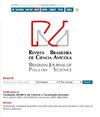Assessment of the water quality of Bar-Bula Village well waters, Tafawa Balewa local government area, Bauchi State, Nigeria
IF 1.1
4区 农林科学
Q3 AGRICULTURE, DAIRY & ANIMAL SCIENCE
引用次数: 0
Abstract
There was a report of health challenges in our study area due to the consumption of water from wells sited in the community. The research was aimed at assessing the water quality parameters of the wells consumed by the villagers towards providing information on the possible health implication(s) of its consumption. Two sampling sites were selected, well 1 and well 2, which were hitherto the sole sources of water in the village. Physicochemical and microbiological quality parameters of samples were done in order to assess their conformance with the specification of Nigerian Standard for drinking water quality (NIS 554-2015). The results indicated that all physical water quality parameters have their mean concentration values below the maximum permissible limits, except colour which had total mean concentrations of 16.5 ± 0.65 TCU and 15.3 ± 0.65 TCU for well 1 and well 2 respectively, are relatively above the allowable unit range of 15 TCU (NIS-554-2015). The water quality assessment of wells also revealed high concentration of Cadmium (0.11 mg L-1 and 0.16 mg L-1, for well 1 and 2 respectively as against 0.003 mg L-1 specified by standard) and Magnesium (185 mg L-1 and 105 mg L-1 for well 1 and 2 respectively as against the maximum permissible limit of 20 mg L-1 specified by the standard). The microbial values of samples fall below the maximum permissible limit prescribed by the NIS standard. From the study, it was concluded that the presence of Cadmium in the well waters indicated that the water is unfit for consumption.尼日利亚包奇州Tafawa Balewa地方政府区Bar-Bula村井水水质评估
在我们的研究区域有一份健康挑战的报告,因为从社区的水井中取水。这项研究的目的是评估村民饮用的水井的水质参数,以便提供有关饮用水井可能对健康造成影响的信息。选取了两个取样地点,井1和井2,这两个地点迄今为止是该村唯一的水源。为评价样品符合尼日利亚饮用水质量标准(NIS 554-2015)的要求,对样品进行了理化和微生物质量参数测定。结果表明,除1号井和2号井的总平均浓度分别为16.5±0.65 TCU和15.3±0.65 TCU外,所有物理水质参数的平均浓度均低于最大允许范围,均相对高于15 TCU的允许单位范围(NIS-554-2015)。水质评价结果显示,1号井和2号井的镉(分别为0.11 mg L-1和0.16 mg L-1,高于标准规定的0.003 mg L-1)和镁(1号井和2号井分别为185 mg L-1和105 mg L-1,高于标准规定的最高允许限值20 mg L-1)的浓度较高。样品微生物值低于NIS标准规定的最大允许限量。研究结果表明,井水中镉的含量表明该井水不适合饮用。
本文章由计算机程序翻译,如有差异,请以英文原文为准。
求助全文
约1分钟内获得全文
求助全文
来源期刊

Brazilian Journal of Poultry Science
农林科学-奶制品与动物科学
CiteScore
1.80
自引率
9.10%
发文量
60
审稿时长
>12 weeks
期刊介绍:
A Revista Brasileira de Ciência Avícola surgiu em 1999 a partir da necessidade que a comunidade científica possuía de um periódico para veiculação e publicação de seus trabalhos, com a publicação de três números anuais.
A Revista conta hoje com um corpo editorial altamente qualificado e com artigos científicos desenvolvidos pelos maiores especialistas da área, o que a cada dia atrai mais leitores em busca de inovação e respaldo técnico.
Devido à credibilidade que conquistou pelos esforços de sus autores, relatores e revisores, a Revista ganhou caráter de coleção, sendo consultada como fonte segura de estudo desenvolvidos na Avicultura.
A partir de 2003 – volume 5 -, a Revista passou a chamar-se Brazilian Journal of Poultry Science, e todos os trabalhos passaram a ser publicados em inglês. No mesmo ano subiu para quatro o número de revistas por volume, ampliando-se assim os trabalhos publicados anualmente.
 求助内容:
求助内容: 应助结果提醒方式:
应助结果提醒方式:


